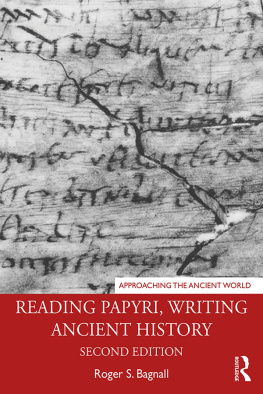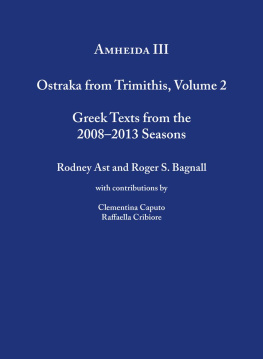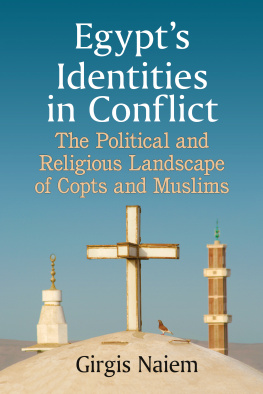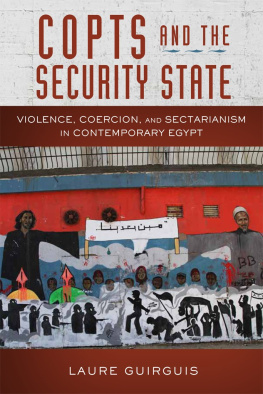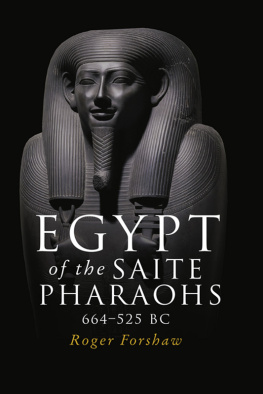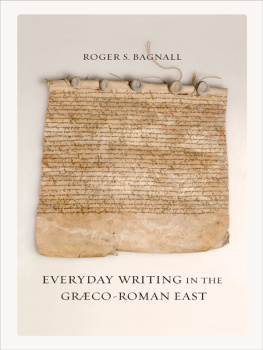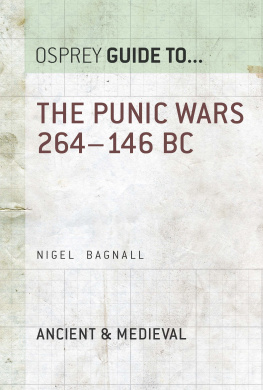Roger S. Bagnall - Egypt: From Alexander to the Copts: An Archaeological and Historical Guide
Here you can read online Roger S. Bagnall - Egypt: From Alexander to the Copts: An Archaeological and Historical Guide full text of the book (entire story) in english for free. Download pdf and epub, get meaning, cover and reviews about this ebook. year: 2017, genre: Home and family. Description of the work, (preface) as well as reviews are available. Best literature library LitArk.com created for fans of good reading and offers a wide selection of genres:
Romance novel
Science fiction
Adventure
Detective
Science
History
Home and family
Prose
Art
Politics
Computer
Non-fiction
Religion
Business
Children
Humor
Choose a favorite category and find really read worthwhile books. Enjoy immersion in the world of imagination, feel the emotions of the characters or learn something new for yourself, make an fascinating discovery.
- Book:Egypt: From Alexander to the Copts: An Archaeological and Historical Guide
- Author:
- Genre:
- Year:2017
- Rating:3 / 5
- Favourites:Add to favourites
- Your mark:
- 60
- 1
- 2
- 3
- 4
- 5
Egypt: From Alexander to the Copts: An Archaeological and Historical Guide: summary, description and annotation
We offer to read an annotation, description, summary or preface (depends on what the author of the book "Egypt: From Alexander to the Copts: An Archaeological and Historical Guide" wrote himself). If you haven't found the necessary information about the book — write in the comments, we will try to find it.
Egypt: From Alexander to the Copts: An Archaeological and Historical Guide — read online for free the complete book (whole text) full work
Below is the text of the book, divided by pages. System saving the place of the last page read, allows you to conveniently read the book "Egypt: From Alexander to the Copts: An Archaeological and Historical Guide" online for free, without having to search again every time where you left off. Put a bookmark, and you can go to the page where you finished reading at any time.
Font size:
Interval:
Bookmark:

EGYPT
From Alexander to the Copts


This electronic edition published in 2017 by
The American University in Cairo Press
113 Sharia Kasr el Aini, Cairo, Egypt
www.aucpress.com
Copyright 2004, 2017 by Roger S. Bagnall and Dominic W. Rathbone
All rights reserved. No part of this publication may be reproduced, stored in a retrieval system, or transmitted in any form or by any means, electronic, mechanical, photocopying, recording, or otherwise, without the prior written permission of the publisher.
eISBN 978 1 61797 584 4
Version 1
CONTENTS
The aim of this guide is to enable the traveller to Egypt, or anyone interested in the archaeology and history of ancient Egypt, to appreciate the rich material legacy of the Hellenistic, Roman and Late Antique (or Byzantine) periods, roughly the millennium from 332 BC to AD 641. This ancient Egypt is not as familiar in general, or as immediately obvious on the ground, as the monuments and civilization of the preceding two millennia and more of pharaonic rule which have always dominated the Western image of Egypt. Most guidebooks focus on the pharaonic past, although there is an enormous amount from this later period to see and study, and much of exceptional beauty and interest.
From 525 to 399 BC, and again from 343, Egypt was part of the Persian Empire. After its conquest by Alexander the Great in 332 BC, it was ruled for the next 300 years by the Ptolemaic dynasty founded by Ptolemy I, one of Alexanders generals. With the defeat of Cleopatra VII in 30 BC, Egypt became a province of the Roman Empire, and subsequently of the Byzantine Empire. For a thousand years, from 332 BC to the Arab conquest in AD 641, Egypt was one of the most prosperous lands of the variegated Mediterranean civilization which developed under Greek and Roman rule. While the Egyptian heritage, especially in religion and art, continued to be vital, Greek and other settlers from all over the Hellenistic and Roman worlds brought with them their own cultural traditions. Christianity then added new influences. The result was a remarkably vibrant and diverse material and intellectual culture.
The visible legacy of this period includes the remains of cities and villages, temples, tombs, churches and monasteries, forts, statues and reliefs, paintings, decorated mummies, craft objects, inscriptions on stone and documents. Some of the most impressive surviving monuments in the Egyptian tradition, like the great temples of Dendera and Edfu, were built in the name of Ptolemaic and Roman rulers. Alexandria and other sites have produced superb Hellenistic mosaics and statuary, and occasional traces of the monumental civic buildings of the Roman period. The so-called Fayyum portraits from mummies are a unique and striking survival from the Roman world. Egypt today remains home to Coptic Christianity with its rich and distinctive architectural and artistic traditions. Tens of thousands of documents of all types, public and private, written on papyrus in Greek and other languages, have survived by accident and give us, in random bursts, a wealth of detailed historical information about events and daily life which is unparalleled in earlier Egyptian history or in any other area of the Greek and Roman worlds. In this guide we include major finds of documents as part of the archaeology, just as we try to place the archaeological remains in their historical context.
We have had to be selective in our choice of sites and objects, and in the amount of detail given. Over 150 sites are described, from Marina el-Alamein on the Mediterranean to Berenike on the Red Sea. We have included major sites and monuments which have now been destroyed or moved, where possible with photographs and reconstructions of how they once appeared. We also cover the objects of our period displayed in the principal museums of Egypt at the present time. The eventual contents of the new museums currently being opened in Alexandria, Cairo and elsewhere are not yet certain; some objects may be moved between museums, and many new objects will be put on display. We include a brief historical introduction and some illustrative glimpses of the world of the papyrus documents. Readers who want more can turn to the fuller, illustrated, historical survey of A. K. Bowman, Egypt after the Pharaohs, 332 BCAD 642 (1986; 2nd edn 1996), and the collection of translated and commented papyrus documents in J. L. Rowlandson (ed.), Women and Society in Greek and Roman Egypt. A Sourcebook (1998).
We give some advice on how to visit sites outside the main tourist areas, and provide GPS coordinates for oasis and desert sites, but travellers should consult a recently updated tourist guide for the practicalities of transport, accommodation and health. From time to time security concerns lead the police to forbid or restrict travel by foreigners in some areas of Egypt, particularly Middle Egypt and the Eastern Desert; anyone planning to visit areas off the normal tourist circuit should seek advice first from their Consulate. Access to ancient sites in Egypt is controlled by the Supreme Council for Antiquities (SCA) and the Tourist and Antiquities Police. Entrance tickets are sold at the gate of sites and museums open to the public; churches and monasteries in current use normally allow visitors. Other sites should not be visited without permission from the Cairo or local headquarters of the SCA. Sites decay easily and must be treated with respect. The acquisition, by any means, of antiquities in Egypt is illegal and subject to severe penalties.
In addition to the twelve main contributors to the first edition of this book, Sarah Clackson contributed 6.5 shortly before her untimely death, and Todd Hickey provided material for ch.1, and Herbert Verreth for 2.7. The complete first draft was read by Don Bailey, who made many valuable suggestions, and parts by Elizabeth S. Bolman. The plans were drawn by Will Foster, the maps by David Cox, and two pictures by Sue Testar (5.3.5,5.4.3). Judith McKenzie contributed her maps of Alexandria and the late Sheila Gibsons axonometric drawings. Martin Richards, the book designer, cheerfully assisted with several illustrations. Help in finding and providing photographs was also given by Sally-Ann Ashton, Elizabeth S. Bolman, Annie Cottry, Sue Davies, Mark Depauw, Darlene Brooks Hedstrom, Marie-Hlne Marganne (Cedopal), Robin Meador-Woodruff, Paul Nicolson, Harry Smith, Thelma K. Thomas, Bart Van Beek and Beatriz Waters. Coralie Hepburn was production editor, and Leslie MacCoull compiled the index. In the writing and editing of this book Dominic Rathbone benefited from a Leverhulme Trust Research Professorship, and Roger Bagnall had research support from Columbia University, and was assisted by Jinyu Liu and Giovanni Ruffini. To all these, and to Nina Shandloff of the British Museum Press, the editors are extremely grateful.
For the revisions for the second edition, Jean-Luc Fournet improved a number of sections and revised the portion of section 6.5.b on Bawit. Daniel Schriever and Agnes Szymanska provided an updated description of the White Monastery and Red Monastery, with the help of Stephen Davis and Elizabeth Bolman. Thomas Landvatter contributed section 8.1. We are indebted to a number of other colleagues for suggestions or new material: Katherine Blouin, Paola Davoli, Jean-Yves Empereur, Wodzimierz Godlewski, Gisle Hadji-Minaglou, Ross Thomas, and Rosario Pintaudi.
Font size:
Interval:
Bookmark:
Similar books «Egypt: From Alexander to the Copts: An Archaeological and Historical Guide»
Look at similar books to Egypt: From Alexander to the Copts: An Archaeological and Historical Guide. We have selected literature similar in name and meaning in the hope of providing readers with more options to find new, interesting, not yet read works.
Discussion, reviews of the book Egypt: From Alexander to the Copts: An Archaeological and Historical Guide and just readers' own opinions. Leave your comments, write what you think about the work, its meaning or the main characters. Specify what exactly you liked and what you didn't like, and why you think so.


